BLOG POSTS ARE PRELIMINARY MATERIALS CIRCULATED TO STIMULATE DISCUSSION AND CRITICAL COMMENT. THE VIEWS EXPRESSED ARE THOSE OF THE INDIVIDUAL AUTHORS. WHILE BLOG POSTS BENEFIT FROM ACTIVE UHERO DISCUSSION, THEY HAVE NOT UNDERGONE FORMAL ACADEMIC PEER REVIEW.
By Leah Bremer, Brytne Okuhata, Jade Delevaux, Angela Richards Doná, Celia Smith, Veronica Gibson, Henrietta Dulai, Aly El Kadi, Kosta Stamoulis, Kimberly Burnett, Christopher Wada
Summary: Climate change and increased groundwater pumping are likely to increase the habitat suitability of an invasive seaweed and decrease the abundance of a native and culturally important limu species in coastal groundwater dependent ecosystems in Kona, Hawaiʻi. Protecting native forests and ensuring sustainable groundwater management that considers the tradeoff between groundwater pumping and the health of groundwater dependent ecosystems, are two actions we can take to protect our native limu. See results in a recent publication in Water Resources Research, a collaboration among UHERO, the Water resources Research Center, the School of Earth Sciences, the School of Life Sciences, and Seascape Solutions.
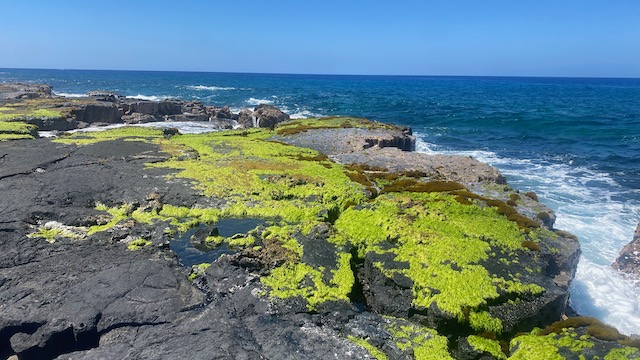
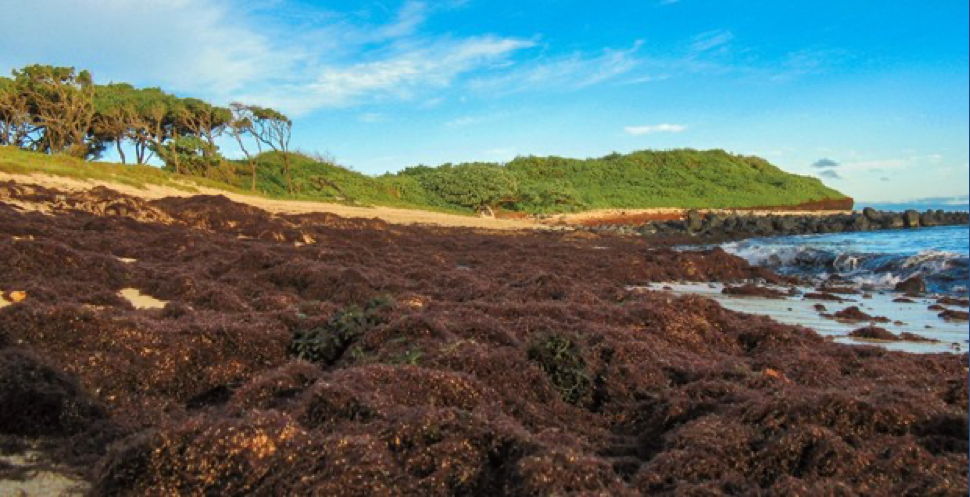

Limu or native seaweeds that populate the coastlines of Hawaiʻi have tremendous cultural value as important and nutritious traditional food sources. They also play a critical role in coastal ecosystems as they are eaten by fish and turtles, and themselves represent unparalleled biodiversity with over 650 native species, an increasing proportion of which are endemic to Hawaiʻi. Hundreds of limu, such as limu kohu, limu kala, and limu pālahalaha, have Hawaiian names indicating their importance in Hawaiian culture and lifeways. Threats from invasive seaweed to climate change have reduced limu along coastlines, but community groups like the Waimanalo Limu Hui, the ʻEwa Limu Project and many others are working to restore limu alongside their linked cultural practices and food systems.
Freshwater (wai) is intricately linked to limu. Many limu grow in brackish conditions near submarine groundwater discharge (SGD) seeping from underground springs, seemingly thriving off of the extra nutrients and the reduced salinity that this freshwater brings to these “groundwater dependent ecosystems.” Less freshwater from climate change, increased groundwater pumping, or changes in watershed management could mean less limu. Because of the link between freshwater and limu as important cultural and ecological resources, limu and the groundwater dependent ecosystems that support them are considered a public trust use of water. According to the Hawaiʻi State Water Code, all water management decisions need to account for public trust uses of water, including culturally and ecologically valued groundwater dependent ecosystems. However, a major challenge is understanding exactly how public trust uses of water, like limu, are affected by interacting drivers of climate change, watershed management, and groundwater pumping.
Understanding these complex land, water, limu linkages is exactly what our interdisciplinary team from UHERO, WRRC, the School of Life Sciences, and the Natural Capital Project set out to do. Our results just came out in a publication in Water Resources Research. Working together, we combined limu lab experiments with limu field data and land-sea modeling to better understand how urban development (and increased groundwater pumping), climate change (and reduced recharge), and native forest protection (maintenance of groundwater recharge) influence nearshore water quantity and quality (salinity and nutrients), and how this influences the growth of a native limu (Ulva lactuca; limu pālahalaha) and an invasive macroalgae (Hypnea musciformis) along the Kona coast of the Keauhou aquifer. Limu pālahalaha is a culturally important limu and a favorite food of green sea turtles (honu). In contrast, Hypnea is not yet present in Kona, but has smothered reefs on Maui, leading to concerns that–were the conditions right–Hypnea could also threaten Kona’s important coastlines.
We first developed an integrated land-sea model that would allow us to model how climate change, future urban development, and native forest protection would influence groundwater quality and quantity and how this then would influence coastal water quality with links to limu and invasive algae photosynthesis and growth. See Figures 1 and 2 from Okuhata et al. (2023) for our modeling framework and ways that our field and lab data helped to calibrate and validate our model.
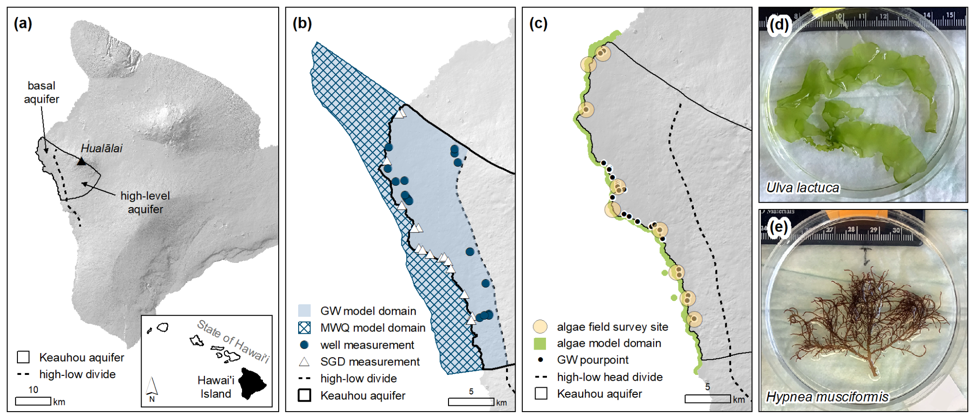

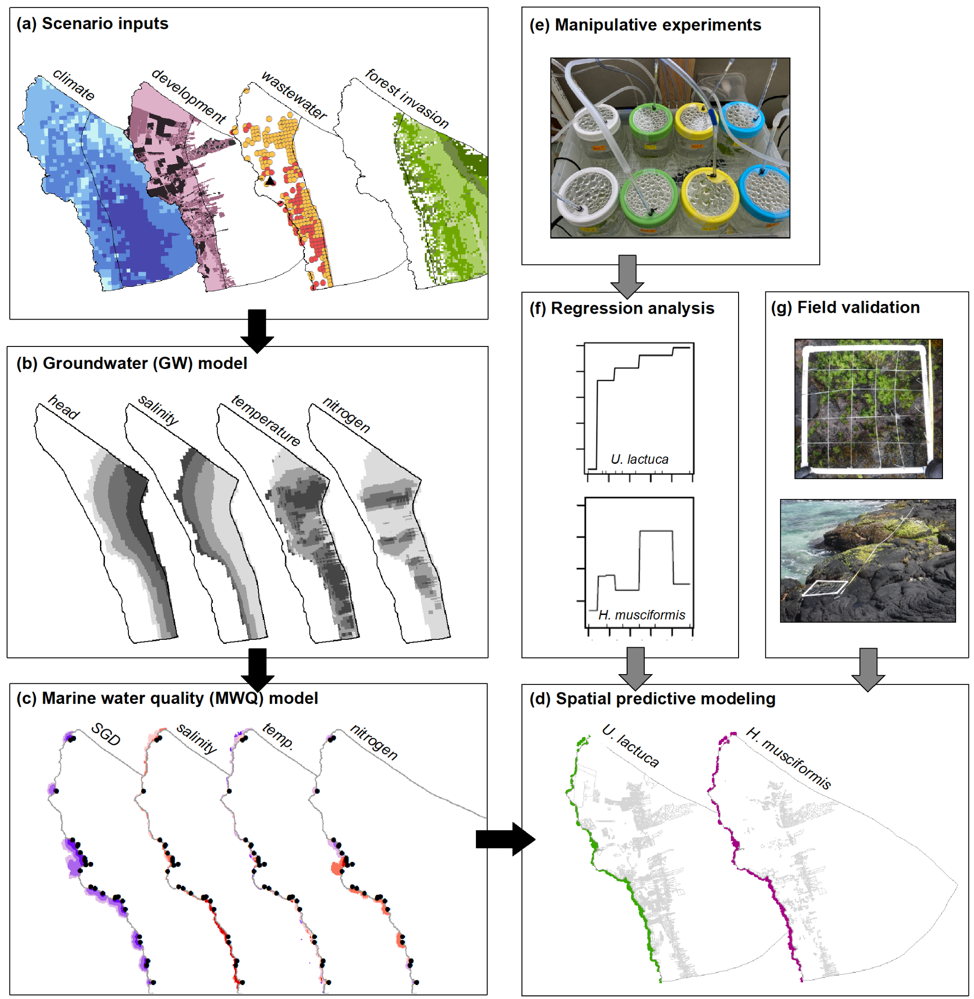

First, we modeled how climate change (in particular a future scenario RCP 8.5 mid-century), urban development, and forest management may influence groundwater quality and quantity and nearshore water quality. We find that reduced rainfall from climate change reduces submarine groundwater discharge and increases salinity of nearshore waters. Next we consider what would happen if all the permitted urban development (urban growth that is permitted, but hasn’t happened yet) were to occur. We find further decreases in groundwater quantity and further increases in salinity of groundwater and nearshore marine water related to the increased pumping necessary to meet the needs of increased development. Increased urban development also increases nutrients (nitrogen and phosphorus) in the groundwater and nearshore water because of wastewater and fertilizer on lawns. Finally, we consider what would happen if, on top of all of this, our existing native forest were not protected, and subsequently was invaded by high-water-use invasive species or were converted to grasses in the fog zone. In this case, we find that protecting native forests prevents the further loss of freshwater and further increases in salinity.
So what does this all mean for limu? Using lab experiments, we found that while limu pālahalaha (Ulva lactuca) photosynthesis and growth tends to increase under SGD (freshwater conditions), Hypnea has a more complex relationship, but tends to prefer saline conditions without freshwater input (see Figure 3).
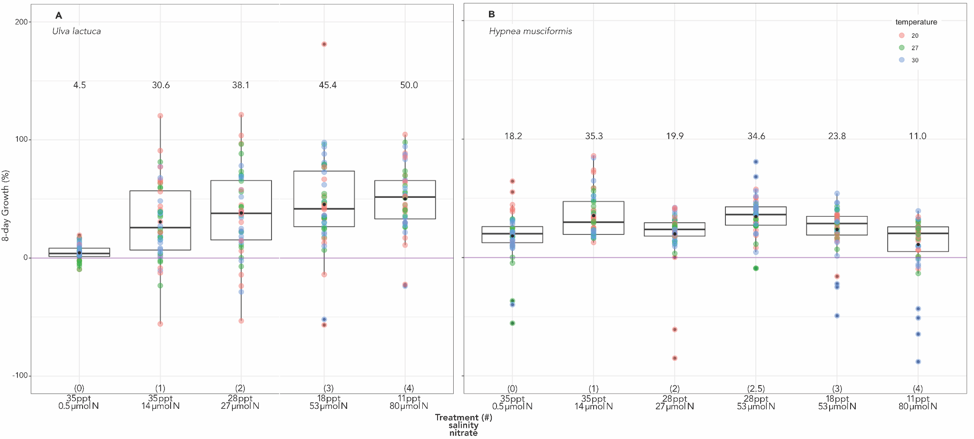

Using our modeling framework, we were then able to translate this to our climate and management scenarios. We find that reductions in groundwater recharge due to climate change are likely to cause an overall decrease in the habitat suitability for limu pālahalaha, but result in an overall increase in habitat for the invasive Hypnea. Urban development exacerbates this as does the conversion of native forest.
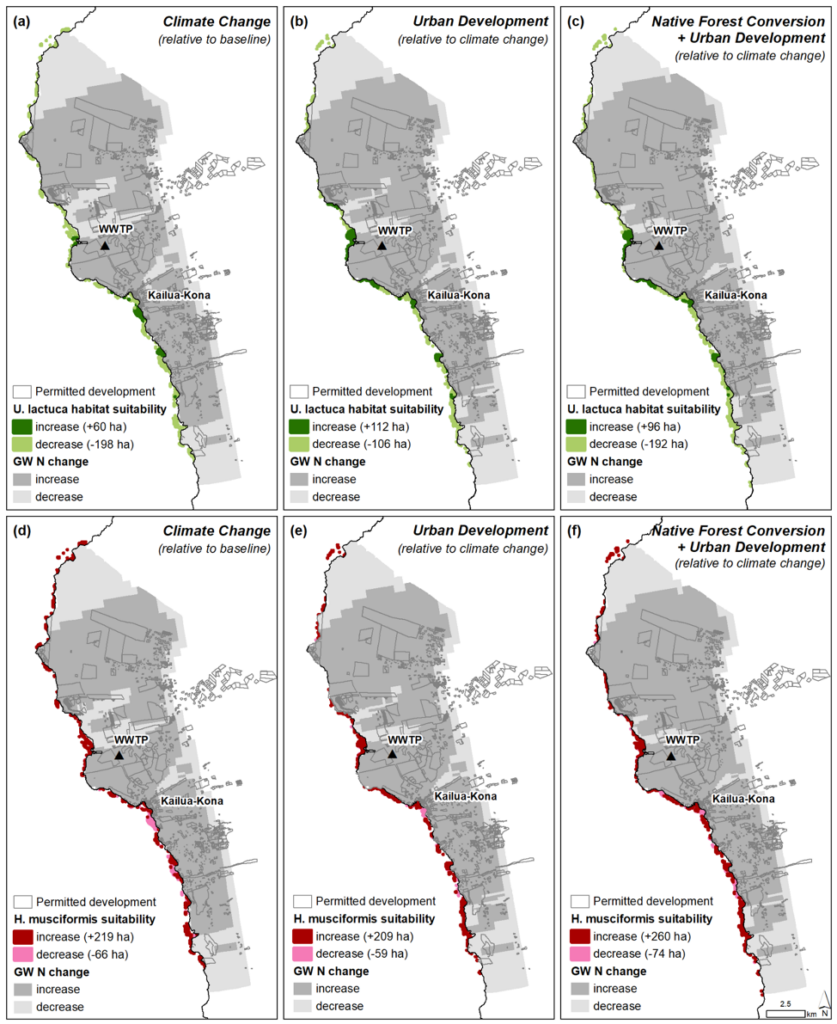

Collectively, this work provides the first quantitative evidence of links between climate change, land-use change, groundwater management and limu, a critical public trust resource. While there is little we can do to directly influence climate change at the global scale, we have the power to influence trajectories of groundwater use and of watershed management. There are several concrete actions we can take to protect limu and the groundwater dependent ecosystems that support them: 1) develop and expand water conservation and reuse initiatives; 2) ensure that new water use is not in conflict with water needed for public trust uses; 3) invest in watershed conservation through the watershed partnerships and other programs; and 4) invest in cesspool upgrades and effective wastewater management.
Future research by our team will explore linkages between wastewater management and limu as well as links between multiple drivers of environmental change and effects on a diversity of limu and invasive macroalgae species. See our previous work on costs and benefits of wastewater management options in Kona and on the biocultural value of groundwater dependent ecosystems in Kona.
Our team would like to acknowledge the West Hawai’i community for their continuous support. We thank the Queen Lili’uokalani Trust, Kamehameha Schools, and the Cesspool Working Group for their insight and guidance. We also thank Kaleo Manuel and Katie Roth of the Commission on Water Resource Management for their constructive feedback and support. Funding for this project came from the USGS Water Resources Research Institute Program Grant G16AP00049 BY5, the Hawai’i EPSCoR Program, funded by the National Science Foundation Research Infrastructure Improvement Award (RII) Track-1: ‘Ike Wai: Securing Hawai’i’s Water Future Award OIA-1557349, the Hawai’i Invasive Species Council PO C21591, and the National Fish and Wildlife Foundation Award 0810.20.068602.



